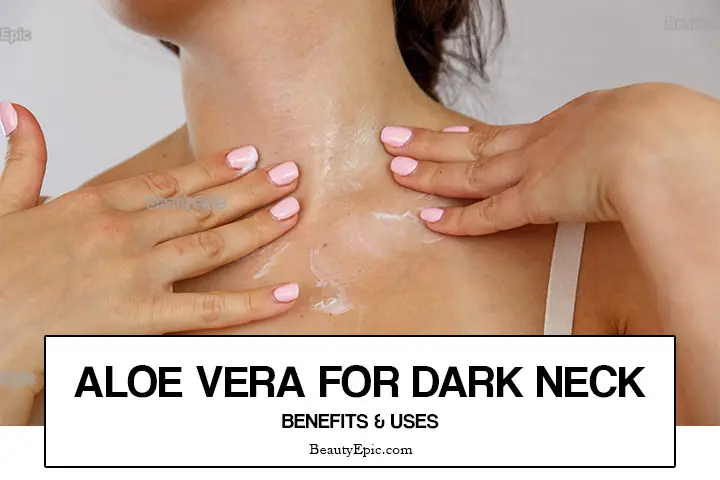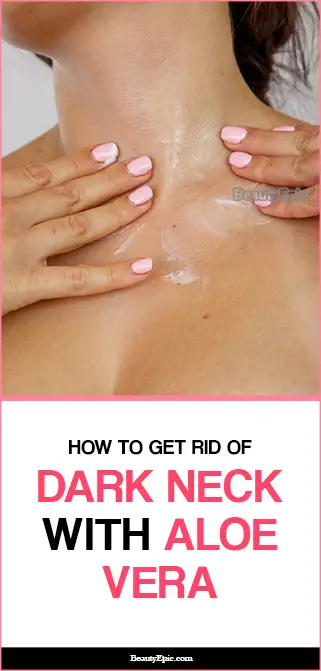
Important: This article is for informational purposes only. Please read our full disclaimer for more details.
For decades, we have been in search of the perfect skin solutions for different parts of our body. This is because our skin portrays a lot bout who we are and how well we take care of ourselves. A good and young looking skin tone will increase our confidence around our peers. On the contrary, an aging and dark skin will make you look old and unattractive.
One of the most important places that highly demands proper skin care is the neck region. A glowing face and a tanned neck is definitely not a good combo. The dark neck skin condition is usually caused by excessive exposure to the sun or basically due to genetic issues. To get rid of it, you may choose to adopt dermatological solutions or simply try home remedies such as applying Aloe Vera skin gel.
Get Rid of Dark Neck with Aloe Vera
Is Aloe Vera Gel Good for Dark Neck?
Aloe Vera is the most natural moisturizing and natural skin lightening agent you may come across among many others. It is widely known to stimulate production of new skin cells hence enhancing skin repair. In addition to that, it contains antioxidants as well as other compounds that will help rejuvenate and repair skin cells. So yes! as much as it looks like a way too simple solution for tanned neck, Aloe Vera works better than most skin-care agents today, Vanessa Luis (2014) Home remedies to treat dark skin on the neck.
[ Read: How to Use Aloe Vera for Dark Spots ]
How to Use Aloe Vera for Dark Neck
The steps involved in using Aloe Vera gel for dark neck is pretty simple and straight forward. All you need is a fresh and succulent Aloe Vera leaf, Ankita (2019) How to lighten the dark neck skin?Tips to lighten the dark neck.
Steps:
- Slice the leaf open and rub the gel directly onto your neck.
- Make sure you deeply apply it into every region.
- Gently massage it on the whole neck region.
- Let it sit for a minimum of 20 minutes and then rinse it off with clean water.
- Repeat this process daily for better results.
[ Read: How to Get Rid of Dark Neck Naturally ]
Aloe Vera Gel for Dark Neck
Aloe Vera gel is one of the best known so far skin care remedy agent known besides others. It is indeed natural and a good way not only to repair patches in the skin, but also get rid of dark spots. Moreover, it is an inexpensive solution and offers a very easy method of use and application.
You may opt to buy your own already made Aloe Vera gel from drug stores and pharmacies or you may make one on your own. To do the latter, all you need to do is slice an Aloe Vera leaf and peel them using a vegetable peeler after letting them dry for 10 minutes. The drying helps drain the resin that has latex which may cause a bit of irritation on the skin, (Wikihow). Thereafter, you need to scoop the get with a knife and add a natural preservative on to it such as powdered vitamin C or E.
Skin care is a fundamental aspect of body care and should not be taken for granted. A good skin will not only make you feel good about yourself, but also impact positively on how the people around you perceive you. The neck is one of the most delicate regions that can be affected by skin tanning. Immediate attention is required as the neck is usually exposed and using Aloe Vera for dark neck is one of the best solutions to this.
You Might Also Like
- Vitamin E Oil for Skin: Everything You Need to Know
- 7 Best Blushes For Asian Skin Tone
- Beverly Hills V-Lift Instant Eye Lift and Eye Tuck Bee Venom Serum
- How to Use Vitamin E Oil to Remove Dark Spots
- Home Remedies for Skin Tightening
- 7 Best Aloe Vera Gels For Hair Growth
- Aloe Vera for Acne Scars – Benefits and How to Use It
- How to Use Aloe Vera for Wrinkles?
- How to Use Aloe Vera to Lighten Dark Elbows
- How to Use Aloe Vera for Dandruff?
- Can Aloe Vera Help Stretch Marks?
- How to Use Aloe Vera for Acne?
- How to Use Aloe Vera for Dark Spots on Face?
- 8 Best Homemade Aloe Vera Hair Mask Recipes
Image:- Shutterstock

















